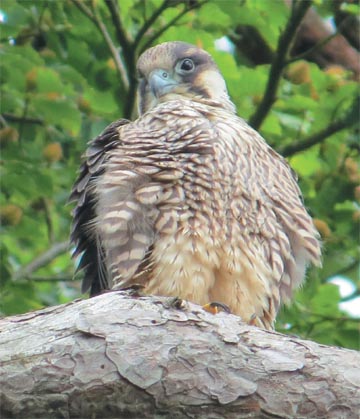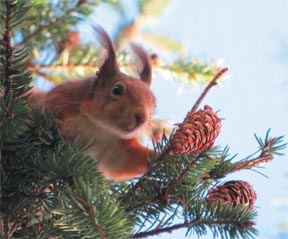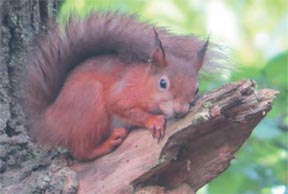|
Wildlife
Newsletter for the Township of Dalkey December 2014 / January 2015 - Michael Ryan |
 Juvenile Peregrine on Killiney Hill - November Photo: M. Ryan |
DON’T
KILL THEM WITH KINDNESS The
RSPB is warning that cooked turkey fat is extremely dangerous to birds
and is urging people not to put the leftover contents of their Christmas
dinner roasting tins outside. Many people (wrongly) believe that it
is as beneficial to birds as other fats, such as lard and suet, but
cooked turkey fat is dangerous for birds for several reasons. It remains
soft even when cooled, meaning it could smear onto birds’ feathers
and ruin their |
|
|
Richard
James, RSPB Wildlife Adviser said: ‘People pour turkey (or other
Christmas joint) fat onto bird tables or mix it with seeds because
they think it will give birds energy and nutrients as things like
fat balls do. But this is a completely different kind of fat and could
have catastrophic effects. |
||
| What
a Year It’s a fair bet at the end of the year we’ll be told it’s been the warmest one in decades. At time of writing it’s cold and very, very wet and it’s nice to reflect on those long warm days which lasted for months and now seem such a distant memory. As well as a record year for the weather it’s probably been a record year for ladybirds as well. I don’t remember ever seeing as many as this year with what seemed like every second nettle leaf on the hill supporting at least one of the little creatures on some days. Although not so many around in early spring by mid to late summer there was a proliferation of butterflies on the wing, with Red Admirals, Peacocks and Small Tortoiseshells reaching and possibly surpassing the populations they had before a succession of dreadful springs and summers and decimated a lot of species. Butterflies were still around well into late autumn and when we were in Waterford in October we counted 10 Red Admirals on one single ivy plant (ivy, though not so popular with gardeners is a great source of nectar for insects in the autumn) and there were still Red Admirals flying on Dalkey Hill in November. Many birds began nesting earlier than usual, taking advantage of the mild weather and the abundance of insects to feed their young with. One result of early nesting I noticed was that Song Thrushes, which often sing well into late |
 A Red Squirrel on a Douglas Fir on Killiney Hill October Photo: M. Ryan |
| June
and July after most songbirds have stopped, had themselves nearly all
stopped well before midsummer, the males presumably having to take up
parental duties and having to give up their long evenings serenading
from tree tops. Of course there were a pair of birds nesting in Dalkey which attained national attention, though for the worst possible reason when someone tried to kill them. I’d seen the Peregrines perched on Dalkey Quarry in late winter and spring but had hoped they were only roosting there and weren’t going to attempt nesting there again after a pair (possibly the same two) had previously nested there in 2006. When I heard there was a nest with eggs in it my heart sank. Although the birds had successfully fledged two young in 2006 they were subjected to a great deal of disturbance, often inadvertent, but sometimes wilfully reckless with people climbing down to take photographs (peregrine chicks will jump out of a nest if frightened). I never mentioned them in previous articles in the newsletter knowing they were frequently subjected to having eggs, chicks or adult birds destroyed but was still shocked when I heard two pigeons covered in poison had been tethered near the nest despite the crowds of people observing the peregrines and the fact they were actually being filmed for a RTE documentary.. Thankfully someone noticed the pigeons and no damage was done. A very impressive number of four chicks fledged. One of our highlights this year was seeing Sparrowhawks mating and immediately afterwards the male hawk flying to a branch on which they subsequently nested and hatched three chicks in late June. When a pair of jays had nested in a nearby conifer they weren’t to know they were going to get a pair of sparrowhawks as neighbours but both families raised young successfully. We’d seen Treecreepers going into a split trunk on a beech tree and thought they might be nesting there and weeks later were lucky enough to see the whole family possibly on the day the chicks had left the nest. The young birds were bunched tightly together, motionless on a tree trunk like one single entity their wings overlapping, resembling a cohort of Roman soldiers in battle formation with overlapping shields held over their heads. When a parent bird would fly in with food the little heads would stick out with gaping beaks. |
 A Red Squirrel chewing - November Photo: M. Ryan |
The
Dalkey Tern project started off very promisingly with a pair of Roseate
terns settling into a nest box on Maidens Rock and laying two eggs and
lots of Arctic terns nesting on Lamb Island. Sadly all the terns on
both locations seemed to have been disturbed and all deserted their
nests. Thankfully there are still Red Squirrels on Killiney and Dalkey
hills. We saw a pregnant female in mid-summer and later saw two reds without the ear clips the researchers put on them signifying they were probably this year’s juveniles and hadn’t been recorded yet. In November we were lucky enough to see two red squirrels, one of them building a winter dray in a scots pine. Although under constant threat from the ever encroaching grey squirrel, where there’s life there’s hope and hopefully there’ll still be reds on the hill this time next year. |